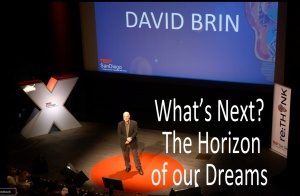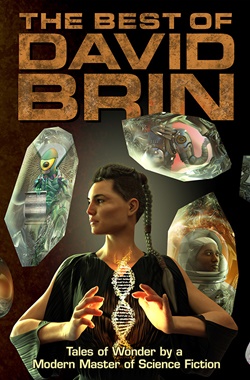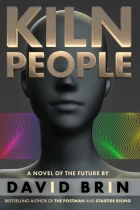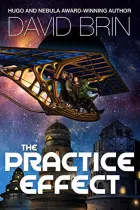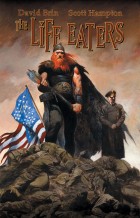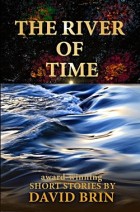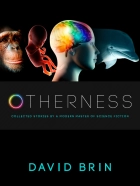A producer’s or director’s tool – or a new kind of art?
Note: this proposal was first broached by me over 20 years ago. And yes, the available technology has caught up at last, making this so obvious that even Hollywood mavens can see it. And – naturally – they are viewing it in exactly the wrong way.
I’ve long proposed a concept for small-scale cinematic storytelling – one that could become a valuable studio pre-production tool, but that might also grow into an exciting medium in its own right, liberating small, writer-led teams to create vivid dramas, whether as first drafts or as final works of popular art.
When I first broached the concept, I called it full-length, animated storvboarding. Now — for reasons that should seem obvious in 2023’s era of AI-rendered art and semi-realistic computer authorship — that name seems obsolete. Yet, I will continue using it in this revision. Because the logic remains almost exactly the same… as does the artistic and commercial opportunity.
Re-examining the traditional screenplay
For more than a century, the initial element in cinema has been the screenplay, generally around 120 pages for a ninety-minute film. While offering detailed dialogue and some scene description, scripts generally remain sketchy about many other aspects. Moreover, screenplays (and their writers) are treated with little respect, viewed as the most disposable or replaceable components of an expensive process.
In coming years, the screenplay, as such, may become obsolete, both to sell an idea for filming and as a working production tool. Instead, a small team consisting of the writer, a computer-animator with AI tools, a photographer, a musical specialist and some voice actors, might team up before hitting the studios with a pitch. Using animatics and integration technologies that already exist, such a team might create a complete 90-minute (or more) cinematic story wherein animated characters act and speak, upon sets that are computer-merged or extrapolated from still-photos or video pans.
While (generally) too crude to display to the public as-such, these animated storyboards would nevertheless be much closer to realization than a mere 120-page bundle of paper sheets. For example, they could include simple musical background with dramatic beats and sound effects at the right places, etc., interwoven with the voiced words that are synchronized with the animations. These full-length drafts might be screened before live or online audiences, swiftly testing alternative plot-twists and endings. They could decisively bridge the gap between writer and finished product.
2023 note: Of course with more modern tools, the ‘storyboard’ as a series of static panels is easily replaced by much smoother animations, AI-generated or assisted. All this means is that a small team can take a script even farther along the pre-production process that I describe here.
Naturally, producers would take to such storyboarding drafts, and view the process as a producer’s tool. Directors would see it as a useful director’s tool, even if they intend to make a standard film with real actors before cameras.
Whatever those two professions believe, the main beneficiaries of such tools will be writers – originators of the core elements, ideas, dialogue, characters and dramatic tension — as they would rise 5 levels of execution closer to final product before relinquishing control.
If producers say “this looks promising, but we’ll want to make changes,” the creative team can say “We’ll be back on Monday with three new versions we can test before focus groups.” All of which can happen before any contracts are signed… leaving the creators in a strong position.
Now, of course crude or partial versions of this notion have been around a long time. Way back when I first posted this forecast, Amazon Storyteller would let you upload a story/script and produce a customizable storyboard. And there was Crazy Talk Animator. ToonBom was another incomplete move in this direction. Alas, none of them became truly liberating, in the way I describe.
A true animated storyboard (AS) or or cinematic draft would flow smoothly. It would have music and use real actors’ voices behind stick-figure or rendered avatar characters. The animation itself would not have to be lavish, just good enough to vividly portray the story+action. In fact, much of the movement can be computer interpolated between artist sketches, almost seamless to the eye.
Think of an animated script… with some scenes rendered more vividly to show off possible special effects. This could then be shopped around to directors & studios, saying “let’s make a deal based on this, and not arm-waved descriptions or an easily trashed sheaf of paper pages.”
One sub-variety – even more economical than the version described here — is the narrated storyboard, as illustrated by the famous Chris Marker film “La Jetee” (later remade as “Twelve Monkeys”) and more recently in “The Life of a Dog” by John Harden. (Both of them are in French, interestingly.) A fertile technique, it has been under-utilized by indie film-makers and could easily be transformed into the full-voiceover version I propose here.
Another cool aspect — the animated storyboard is a product in itself! Time and again it has been shown that people can accept and identify with very crude and even cartoony representations, so long as the drama, pace, music, dialogue and voices are first rate. Even talking and moving stick figures (or a little better) can draw empathy and tears from an audience. Such full, feature-length renderings of a story might draw an avid community of fans or followers online, if the sequence of words-action-emotions and music are well done. And if that online following is all the story gets, at first? Well, fine, there are monetization methods… and there would soon be awards.
Moreover, if an Animated Storyboard feature does gain a cult following online? That might lead to interest from producers later on, giving the story a second chance.
Ideally, we’re envisioning a product that enables a writer and a few specialists, plus several voice actors, to interact under the leadership of a “director” knowledgeable in the program itself. A team of half a dozen could make a 90 minute feature, crude, but with incredible swiftness and agility, sometimes achieving drama better than many products coming out of studios today.
If I am right about this, we’ll soon see.
And hear and feel.






 In coming years the screenplay, as such, may become obsolete, both to sell an idea for filming and as a working production tool. Instead, a small team consisting of the writer, a computer-animator, a photographic specialist, a musical specialist and some voice actors might team up before hitting the studios with a pitch. Using animatics and integration technologies that already exist, such a team might create a complete 90 minute cinematic story wherein animated characters act and speak upon sets that are computer-merged from still-photos or video pans.
In coming years the screenplay, as such, may become obsolete, both to sell an idea for filming and as a working production tool. Instead, a small team consisting of the writer, a computer-animator, a photographic specialist, a musical specialist and some voice actors might team up before hitting the studios with a pitch. Using animatics and integration technologies that already exist, such a team might create a complete 90 minute cinematic story wherein animated characters act and speak upon sets that are computer-merged from still-photos or video pans.

 The Matrix
The Matrix

 1- similarity — make something similar to the object you seek to control. A voodoo doll of a person. Or a model of a valley where you want rain to fall.
1- similarity — make something similar to the object you seek to control. A voodoo doll of a person. Or a model of a valley where you want rain to fall.


 After Hunger games and Divergent and Ender’s Game and Harry Potter and Game of Thrones, is it possible to see a theme? Other than a fetish for the word “game”? How about this:
After Hunger games and Divergent and Ender’s Game and Harry Potter and Game of Thrones, is it possible to see a theme? Other than a fetish for the word “game”? How about this: Oh, noteworthy: this trait encompasses both left AND right.
Oh, noteworthy: this trait encompasses both left AND right.


